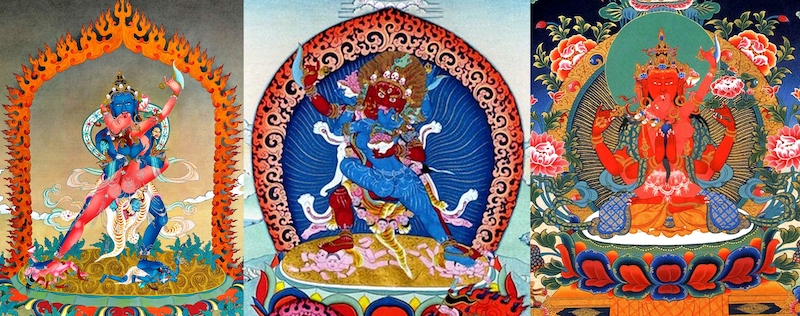Vajravari in union with her consorts
Vajravarahi (Tib. Dorje Phagmo) is a wrathful aspect of the Tantric goddess Vajrayogini. Vajravarahi can be translated as “diamond sow.” She symbolizes the supreme power that removes all obstacles on the path to enlightenment, as well as the passion, compassion, and wisdom that overcomes ignorance and attachment to the illusory self.
Vajravarahi has the typical characteristics of the wrathful deities. Her distinguishing feature is the head of a sow, which is usually depicted behind her right ear or above her head. This iconographic element makes some scholars believe that Vajravarahi originates from Hindu goddess Varahi. Wild sow plays an important role in Indian religions with its power, fearlessness, and invincibility. Tibetan sources interpret the sow’s head as a sign of victory over ignorance and delusion, as well as overcoming desires and attachments.

The main iconographic form of Vajravarahi is red in color, with one face, three eyes and a wrathful expression. Usually she is depicted with two hands, in which she holds the same attributes as Vajrayogini: in the right – a curved knife (Tib. driguk), and in the left – a kapala (skull cup) filled with blood and a trident (Tib. tsesum). She is standing in a dancing manner with the left leg extended in a half in a vajrasana (diamond posture). Her feet stepped on a corpse, symbolizing the victory over the ego and the elimination of illusions. Flames of primordial wisdom are often depicted around her figure.
There is also a white form of Vajravarahi, which has a peaceful expression. Her figure is in the same pose and with the same attributes as the red one. It is related to the school of Kashmiri pandit Shakya Sribhadra, who visited Tibet in the period 1206-1218.

Unlike most female deities in the Buddhist tradition, who usually are depicted with only one consort, Vajravarahi can be seen in union with various forms of the male enlightened nature. Her main consort is Heruka Chakrasamvara (Tib. Khrolo Demchog). When he appears in union with Vajravarahi, he is called Sahaja Chakrasamvara. The Sanskrit word sahaja (Tib. lhenkye) means “spontaneous” or “natural” and expresses the nature of the non-dual union of the deities.

Vajravarahi is also depicted as the consort of Hayagriva (Tib. Tadrin) – a wrathful emanation of Bodhisattva of compassion, Avalokiteshvara (Tib. Chenrezig). There is a specific form called Hayagriva Vajravarahi Chintamani (Tib. Tapag Yishin Norbu) in which the two deities are in union in a dancing pose. Hayagriva is red in color, with a curved knife in the right and a kapala in the left hand. Vajravarahi is blue in color, with the same attributes. Both deities have wrathful expression and flames of wisdom fire are depicted around their bodies. The couple also appears in the Yangzab cycle of Dzogchen teachings. Through this practice one attains the essence of Padmasambhava as a guru, Hayagriva as a deity of meditation and Vajravarahi as a dakini.

Vajravarahi is also the spiritual wife of Avalokiteshvara in his specific form, called Jinasagara (Tib. Gyalwa Gyatso). He is red in color, with four hands. With two of his hands he holds a gem in front of his heart, hugging his consort and with the other two holds a vajra in the right and a lotus in the left. Vajravarahi is also red in color and holds her usual attributes. This specific form of both deities is related to the Kagyu School of Tibetan Buddhism. It is at this school that the goddess is most revered, as she is considered the personal dakini of her primary teachers Marpa (1012–1097), Milarepa (1052-1135), and Gampopa (1079–1153).

